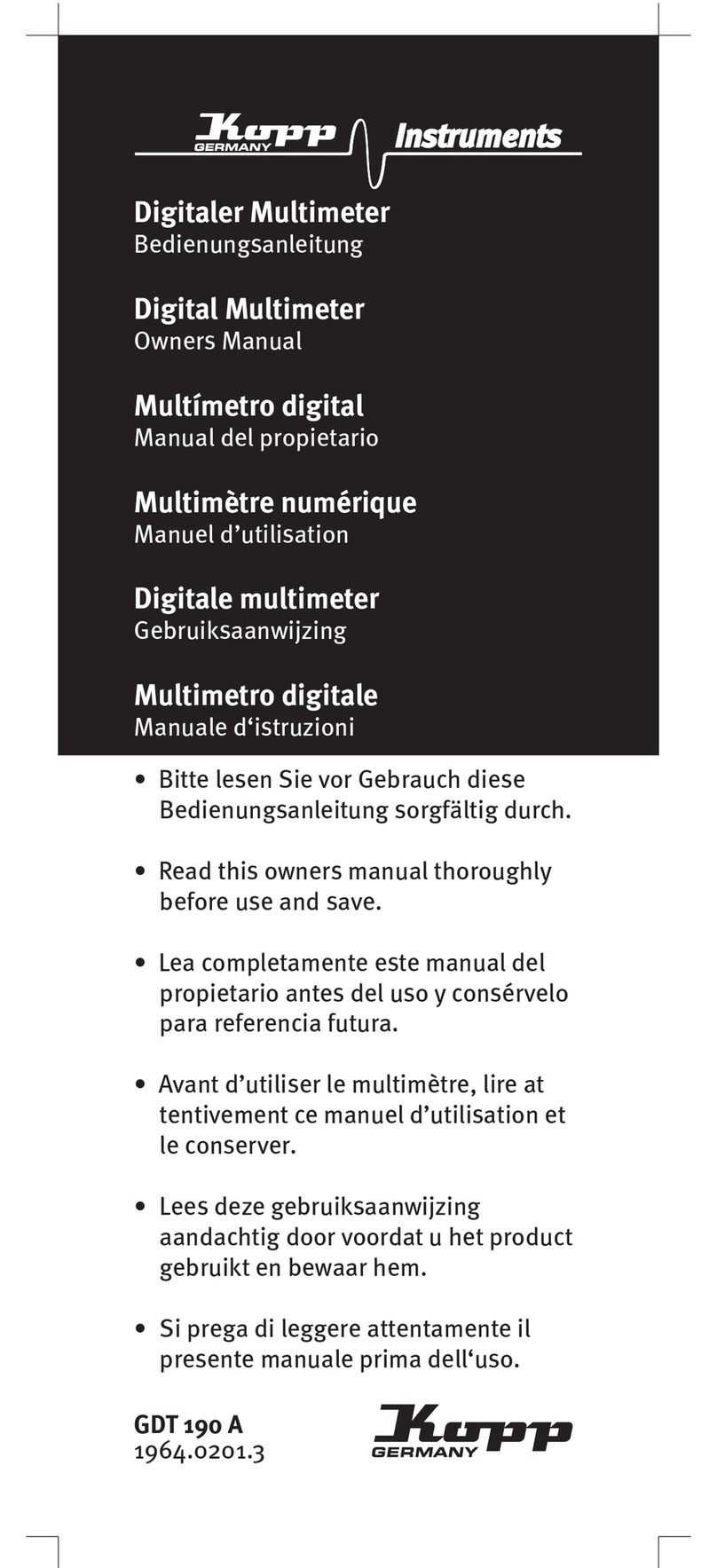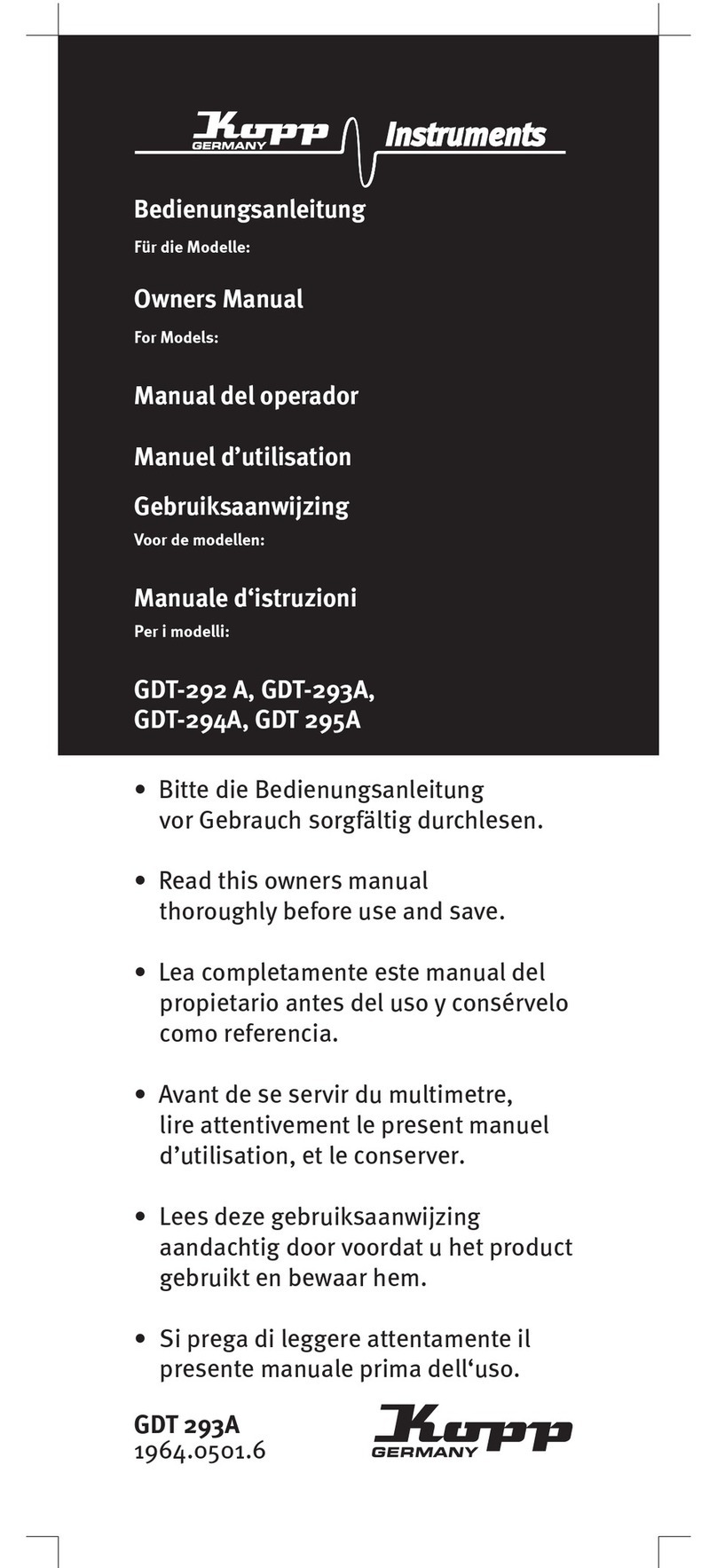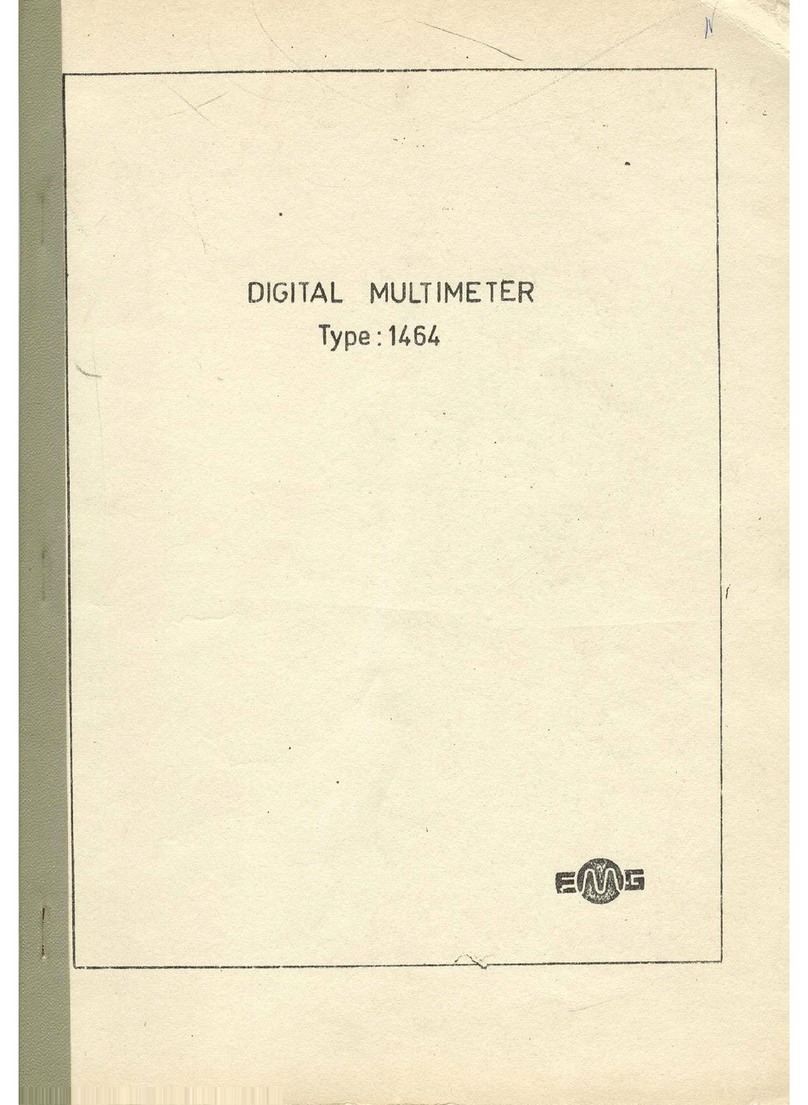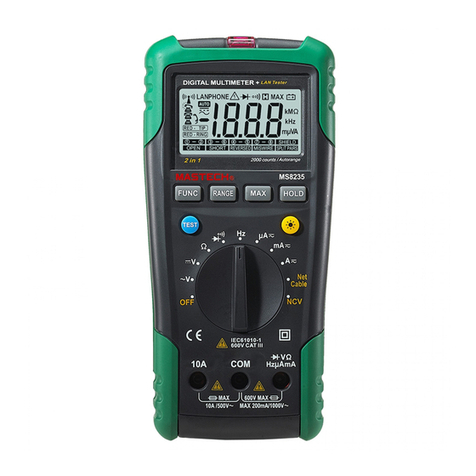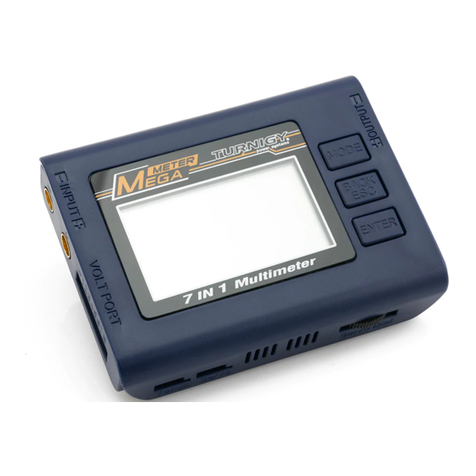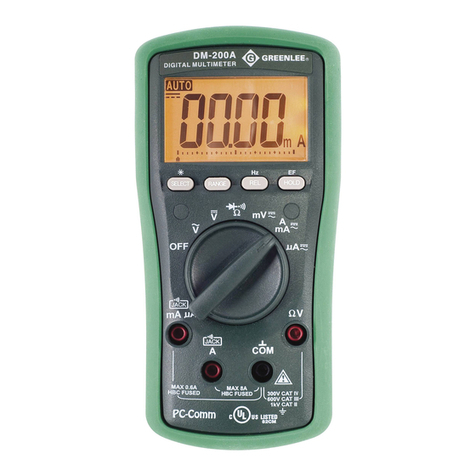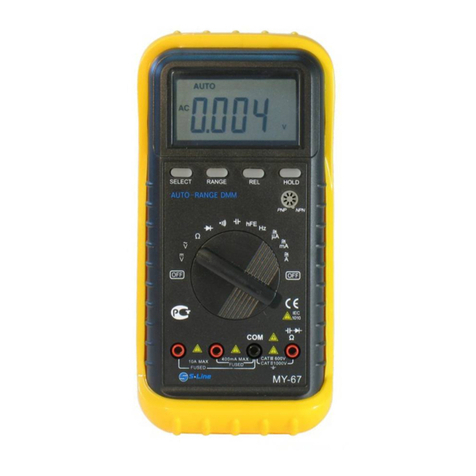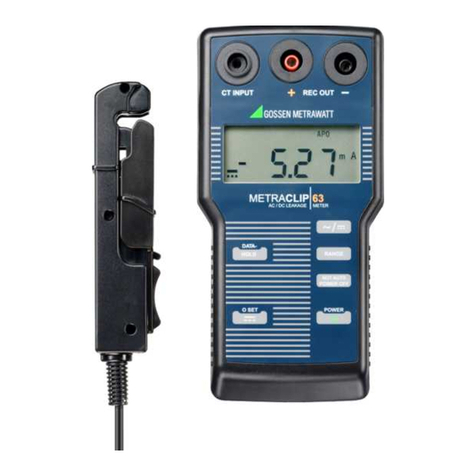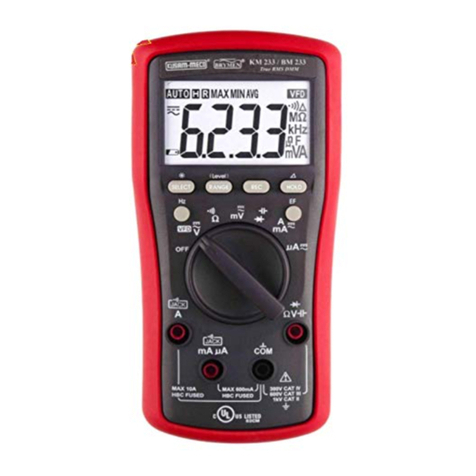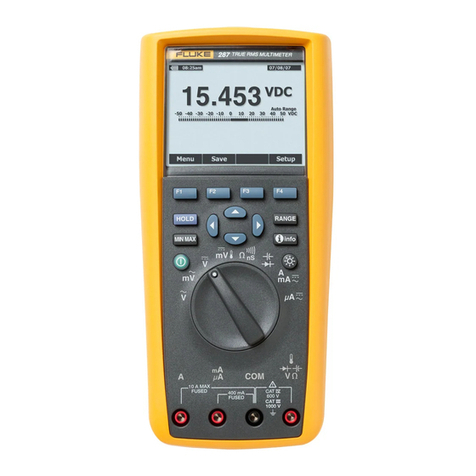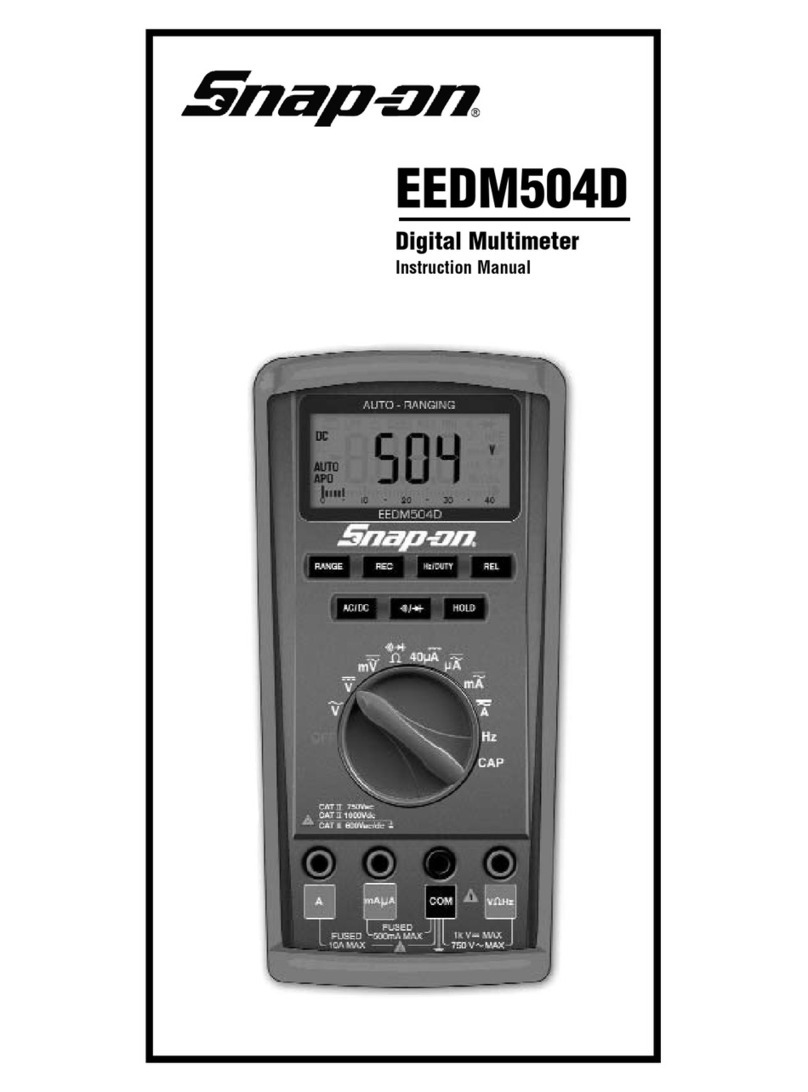Kopp GMT-12A User manual

Analoger Multimeter
Bedienungsanleitung
Analog Multimeter
Owners Manual
Multímetro analógico
Manual del propietario
Multimètre numérique
Manuel d’utilisation
Analoge multimeter
Gebruiksaanwijzing
Multimetro digitale
Manuale d‘istruzioni
• Lesen Sie diese Bedienungsanleitung
vor Gebrauch sorgfältig durch.
• Read this owners manual thoroughly
before use and save.
• Lea completamente este manual del
propietario antes del uso y consérvelo
como referencia.
• Avant de se servir du multimetre,
lire attentivement le present manuel
d’utilisation, et le conserver.
• Lees deze gebruiksaanwijzing
aandachtig door voordat u het product
gebruikt en bewaar hem.
• Si prega di leggere attentamente il
presente manuale prima dell‘uso.
GMT-12A
1943.0102.4

Inhalt
Seite 2 Gerätefunktionen
Seite 3 Ausstattung
Seite 3 Sicherheitshinweise
Seite 3 Anwendungshinweise
Seite 4 Justierung vor Messbeginn
Seite 5 Batteriezustandsanzeige
Seite 5 Messung von Gleichspannung
Seite 6 AC Spannungsmessung
Seite 6 Widerstands bzw. Durchgangsmessung
Seite 7 Dezibelmessung
Seite 7 Batterie- und Sicherungsaustausch
Anzeige-
nadel
Gerätefunktionen
Abbildung 1
Analoge Anzeige
Batterie /
Sicherungsfach
Anzeige-
justierung
Bereichs-
auswahlrad
Eingangsbuchsen
Null-
Ω
Ein-
stellung
Spiegel für
Anzeigenadel
2

Ausstattung
Bereiche:
12 Messbereiche
DC V:
10-50-250-500 V
AC V:
10-50-250-500 V
DC mA:
0.5-50-250mA
Widerstand
Ω
:
Rx1K (Angezeigter Widerstandswert x 1000)
Max. 1 M
Ω
Dezibel:
-20dB bis +56dB im „AC V“-Bereich
Genauigkeit:
DC V, mA = 4% bei Vollausschlag
AC V = 5% bei Vollausschlag
Resistance = 4° (über den Anzeigebereich)
Empfi ndlichkeit:
2000
Ω
/V DC and AC
Drehschalter Funktionswahl:
5 Funktionen
13 Positionen
12 Messbereiche
0
Ω
-Justierung:
Auf der linken Geräteseite befundet sich das Einstellrad zur
Nullung bei Widerstandsmessungen. Hierfür die Messleitun-
gen kontaktieren und mit dem Stellrad auf „0“ justieren.
Einstellschraube zur Justage der Anzeigenadel:
Unter dem Anzeigefeld befi ndet sich die Einstellschraube zur
Nadeljustage.
Skalenspiegel:
In dem verspiegelten Feld auf der Skalenoberfl äche ist die
Anzeigenadel zu sehen. Dieses dient der Eliminierung von
Ablesefehlern, welche durch Refl ektion oder unterschiedliche
Ablesewinkel hervorgerufen werden könnten.
Versenkte Eingangsbuchsen:
Negativ (-) für die schwarze Messleitung, positiv (+) für die
rote Messleitung.
Wichtig:
Lesen Sie die Betriebsanleitung vor Gerätegebrauch genau
durch. REGELN DER ELEKTROTECHNIK BEACHTEN!
3

Widerstands (
Ω
) Skala
DC V &
mA Skala
Hauptmarkierungen
für die AC V und DC V
Skalen
dB Skala für Transis-
tormessungen
AC V Skala
Justierung vor Messbeginn
Stecken Sie die Messleitungen in die dafür vorgesehenen
Eingangsbuchsen. Falls nötig, nehmen Sie einen kleinen
Schlitzschraubendreher und drehen Sie die Einstellschraube
nach links oder rechts bis die Anzeigenadel genau über „0“
auf dem linken Skalenende steht.
Analoge Anzeige: Richtiges Ablesen der Anzeige
Widerstand
Ω
Verwenden Sie die obere Skala zum Ablesen des Widerstands-
wertes. Falls der Messbereich X1K ausgewählt wurde, ist der
Ablesewert mit 1000 zu multiplizieren.
DC V Gleichspannung
Verwenden Sie die mittlere, direkt unter dem Spiegel ange-
ordnete Skala. Wählen Sie einen Skalenbereich, der sich in
Verbindung mit dem ausgewählten Messbereich am besten
ablesen bzw. multiplizieren lässt (z.B. für 500V - lesen Sie den
Wert auf der 50V-Skala ab und multiplizieren diesen mit 10)
AC V Wechselspannung
Gleiche Vorgehensweise und Verwendung der gleichen
Zahlen wie bei DC V. Verwenden Sie die Skala direkt unter den
schwarzen Zahlenwerten.
DC mA
Gleiche Vorgehensweise und Verwendung der gleichen Zahlen
wie bei DC V.
Dezibel (dB)
Verwenden Sie die mit dB bezeichnete Skala und die rechts
unten auf dem Anzeigefeld aufgedruckte Tabelle zur Umrech-
nung.
4

Feststellung des Batteriezustandes
Vor der Durchführung von Widerstandmessungen oder Durch-
gangsprüfungen, sollte der Zustand der Gerätebatterie über-
prüft werden. Wählen Sie hierzu den Bereich Rx1K aus und
kontaktieren dann die beiden Messspitzen miteinander. Die
Anzeigenadel sollte sich nach rechts bewegen. Nun weiter die
Messleitungen kurzschließen und das „0
Ω
“-Stellrad auf der
linken Geräteseite drehen, bis der Zeiger auf 0
Ω
steht. Sollte
dies nicht möglich sein, sprich der Zeiger erreicht nicht den
rechten Skalenrand, muss die Batterie ausgetauscht werden.
DC V Messung von Gleichspannung
1) Stecken Sie die Messleitungen vollständig in die entspre-
chenden Eingangsbuchsen. (-) schwarze Messleitung, (+)
rote Messleitung.
2) Mit dem Funktionsstellrad den entprechenden DC V-Bereich
auswählen. Falls der zu erwartende Messwert nicht
bekannt ist, den höchsten Messbereich auswählen. Wenn
die Meßwerthöhe bekannt ist, anschließend einen mög-
lichst niedrigen Meßbereich auswählen um die Messgenau-
igkeit zu erhöhen.
3) Falls die Polarität bekannt ist, die schwarze Messleitung
mit dem Neutralleiter verbinden. Falls die Polarität nicht
bekannt ist und die Anzeigenadel bewegt sich nicht nach
rechts, die Messleitungen tauschen.
Verwenden Sie die nachfolgende Tabelle als Hilfe zum richti-
gen Ablesen der Skala.
Ausgewählter Abzulesende Abgelesenen Wert
DC V-Bereich Skala multiplizieren mit:
10 0-10 1
50 0-50 1
250 0-250 1
500 0-50 10
5

DC mA Messungen
1) Stecken Sie die Messleitungen vollständig in die entspre
chenden Eingangsbuchsen.
2) Mit dem Funktionsstellrad den 250DCmA-Bereich wählen.
3) Die Messleitungen in Reihe zum Stromkreis. Sollte sich die
Anzeigenadel nach links bewegen, sind die Messleitungen
zu tauschen. Ableseskala 0-250
AC V Messung von Wechselspannung
1) Stecken Sie die Messleitungen vollständig in die entspre-
chenden Eingangsbuchsen.
2) Mit dem Funktionsstellrad den entprechenden AC V-Be-
reich auswählen. Falls der zu erwartende Messwert nicht
bekannt ist, den höchsten Messbereich auswählen. Wenn
die Meßwerthöhe bekannt ist, anschließend einen mög-
lichst niedrigen Meßbereich auswählen um die Messgenau-
igkeit zu erhöhen.
3) Mit den Messleitungen die zu messenden Punkte kontak-
tieren. Bei Wechselspannung spielt die Polarität keine
Rolle.
Verwenden Sie die nachfolgende Tabelle als Hilfe zum richti-
gen Ablesen der Skala.
Ausgewählter Abzulesende Abgelesenen Wert
AC V-Bereich Skala multiplizieren mit:
10 0-10 1
50 0-50 1
250 0-250 1
500 0-50 10
Widerstandsmessung und Durchgangsprüfung
Bei Widerstands und Durchgangsmessung
STROMLOS
ma-
chen!
1) Die Messleitungen in die dafür vorgesehenen Buchsen
stecken.
2) Wählen Sie den Bereich Rx1K aus und kontaktieren dann
die beiden Messspitzen miteinander. Nun das „0
Ω
“-Stell
rad auf der linken Geräteseite drehen, bis der Zeiger
auf dem rechten Skalenende auf 0
Ω
steht. Sollte dies nicht
möglich sein, sprich der Zeiger erreicht nicht den rechten
Skalenrand, muss die Batterie ausgetauscht werden.
6

Dezibelmessung
1) Stecken Sie die Messleitungen volständig in die entspre
chenden Eingangsbuchsen.
2) Mit demFuntionsstellrad einen AC V-Bereich wählen und
den Messwert auf der unteren roten dB-Skala ablesen. Je
nach ausgewähltem Meßbereich ist der Messwert mit Hilfe
der unten rechts aufgedruckten Tabelle umzurechnen.
Wichtig:
Für absolute dB-Messungen muss ein Inpendanzwert von
mindestens 600
Ω
vorliegen. -0- dezibel = 1 milliwatt bei 600
ohm Impendanz (Äquivalent zu 0.775 V über 600
Ω
).
Batterie und Sicherungswechsel
1) Entfernung der Schraube(n) auf der Geräterückseite. Batte-
rieabdeckung vorsichtig abheben.
2) Beim Batteriewechsel auf korrekte Polarität achten.
3) Ersatzsicherung 05/205V
4) Batterieabdeckung vorsichtig einsetzen und mit Schrauben
einsetzen. Schraube nicht zu fest andrehen um Gehäuse-
oder Schraubenbeschädigungen zu vermeiden.
7

Contents
Page 8 Meter Functions
Page 9 Specifi cations
Page 9 For Your Safety
Page 9 Operating Suggestions
Page 10 Preliminary Adjustments
Page 11 Internal Battery Condition
Page 12 DC Voltage Measurement
Page 12 AC Voltage Measurement
Page 12 Resistance/Continuity Measurement
Page 13 Decibel Measurement
Page 13 Battery and Fuse Replacement
Meter Functions
Figure 1
Analog Scale
Battery/Fuse
Cover
Input Jacks
Zero Ohms
Adjust ment
Mirror
Needle
Zero Adjust
Screw
Function/Range
Selector Switch
8
Zero Ohms

Specifi cations
Ranges:
12 measuring ranges
DC Voltage:
10-50-250-500 Volts
AC Voltage:
10-50-250-500 Volts
DC Current (Milliamperes):
0.5-50-250mA
Resistance (Ohms):
Rx1K (resistance indicated multip-
lied by 1000)
1 Megohm max
Decibels:
-20dB to +56dB on AC voltage
ranges
Accuracy:
DC voltage, mA = 4% full scale of
range
AC voltage = 5% full scale of range
Resistance = 4° arc of scale length
Sensitivity:
2000 ohms per volt DC and AC
Function/Range Switch:
5 functions
13 positions
12 measuring ranges
Zero Ohms Adjustment Dial:
Located on the left side of the housing; adjustment dial is
used to zero the needle indicator on the ohms scale while
shorting the test leads together.
Mechanical Zero Adjustment Screw:
Located directly below the center of the meter scale; adjust
needle indicator to read zero at the left side of the scale before
taking any measurement.
Mirrored Scale Plate:
The mirror on the scale plate is used to line up the needle with
its refl ection to improve the reading accuracy by preventing
parallax error.
Recessed Input Jacks:
Negative (-) input jack for black test lead, positive (+) input
jack for red test lead.
Important:
Read this operators manual thoroughly before using this mul-
timeter. This manual is intended to provide basic information
regarding this multimeter and to describe common test pro-
cedures which can be made with this unit. Many types of ap-
pliance, machinery and other electrical circuit measurements
are not addressed in this manual and should be handled by
experienced service technicians.
9

Resistance
(Ohms) Scale
DC Voltage &
Milliamps Scale
Common Mar-
kings for both
the AC & DC
Voltage Scales
dB Scale for Transis-
tor Gain Measure-
ment
AC Voltage
Scale
Preliminary Adjustments
Fully seat the test leads in the correct input jacks. If necessary,
using a small fl at tip screwdriver, slowly turn the mechanical
zero adjustment screw clockwise or counterclockwise until the
needle indicator is directly over the three black zeros at the
left end of the scale.
Analog Meter:
Reading the Scale General
Resistance (Ohms -
Ω
)
Use the top scale for reading the resistance. If the meter is set
to X1k, multiply the resistance value by 1000
Ω
.
DC Voltage (V DC)
Use the middle scale directly below the mirror. Match the dial
setting to the highest number on the scale. If the setting does
not match one of the numbers, use a scale that can be easily
multiplied to give the setting (i.e. - for 500V, use the 50V scale
and multiply the reading by 10).
AC Voltage (V AC)
Use the same numbers and procedures as used for the DC
voltage setting, but use the scale directly below the numbers.
DC Milliamps
Use the same scale and procedure as used for the DC voltage
setting.
Decibel Gain (dB)
Use the scale marked dB to read decibels. Use the chart at the
right of the scale for proper conversion.
10
AC Voltage

Internal Battery Condition
Before making resistance or continuity tests, check the condi-
tion of the internal battery. First turn the function/range switch
to the ohms Rx1K position. Short the test leads together and
the needle indicator should defl ect to the right side of the
scale. Keep the test leads shorted together while simultane-
ously turning the zero ohms adjustment dial until the needle
indicator reads zero at the right side of the ohms (green) scale.
If the needle will not zero, replace the battery with a new 1.5
volt AA size battery (see Battery Replacement).
DC Voltage Measurement
1) Fully seat the test leads in the correct input jacks, (-) black
lead, (+) red lead.
2) Set the function/range switch to the appropriate DC voltage
range. If the voltage is unknown, use the highest range. If
the voltage applied falls within the range of a lower setting,
reset the function/range switch to the appropriate setting
for greater accuracy.
3) If the polarity of the circuit to be tested is known, touch
the black test lead to the neutral side. If the polarity is
unknown, touch the test leads to opposite sides of the
circuit. If the needle indicator defl ects to the left of the
scale, reverse the test leads.
Use the chart below as a guide to reading DC voltage measu-
rements:
DC V range setting Read following and multiply
scale reading by:
10 0-10 1
50 0-50 1
250 0-250 1
500 0-50 10
11

DC Milliamp Measurement
1) Fully seat the test leads in the correct input jacks.
2) Set the function/range switch to the 250 DCmA setting.
3) Put the test leads in series with the circuit (in line with
the circuit) so that the circuit current passes through the
multimeter in order to make the measurement. If the need-
le indicator defl ects to the left, reverse the test leads. Read
the measurement on the 0-250 scale.
AC Voltage Measurement
1) Fully seat the test leads in the correct input jacks.
2) Set the function/range switch to the appropriate AC voltage
range. If the voltage is unknown, use the highest range. If
the voltage applied falls within the range of a lower setting,
reset the function/range switch to the appropriate setting
for greater accuracy.
3) Touch the test leads to the circuit under test. With AC volta-
ge, the polarity of the test leads is not a factor.
Use the chart below as a guide to reading AC voltage measure-
ments:
AC V range Read following and multiply
setting scale reading by:
10 0-10 1
50 0-50 1
250 0-250 1
500 0-50 10
Resistance/Continuity Measurement
For resistance and continuity testing POWER MUST BE OFF:
1) Fully seat the test leads in the input jacks.
2) Set the function/range switch to the Rx1K position (resis
tance indicated multiplied by 1000) and short the test
leads together. Using the zero ohms adjustment dial,
slowly turn the dial until the needle indicator reads -0-
ohms at the right end of the ohms scale. If the needle will
not zero, replace the internal battery with a new 1.5 volt AA
size battery (see Battery Replacement).
12

Decibel Measurement
1) Fully seat the test leads in the correct input jacks.
2) Set the function/range switch to any one of the AC voltage
ranges and read the decibel measurement on the bottom
(red) scale of the faceplate. Based on the AC voltage range
you selected, you will need to compute the actual measu-
rement by using the decibel conversion chart located at the
bottom right of the faceplate.
Important:
For absolute decibel measurements, circuit impedance must
be at least 600 ohms. -0- decibels = 1 milliwatt in a 600 ohm
impedance (equivalent to 0.775 volts across 600 ohms).
Battery and Fuse Replacement
1) Remove the screw in the back cover of the meter and care-
fully separate the back cover from the front.
2) Note the polarity of the battery when removing it from its
compartment and replace.
3) Use GB catalog number GF-0306 0.5A/250V replacement
fuses.
4) Carefully replace the back cover and tighten the screw. Do
not overtighten, as this may strip the threads in the meter
housing.
13

Contenido
Página 14 Funciones del probador
Página 15 Especifi caciones
Página 15 Para su seguridad
Página 15 Sugerencias de operación
Página 16 Ajustes preliminares
Página 17 Estado de la batería interna
Página 17 Medición de voltaje DC
Página 18 Medición de voltaje AC
Página 18 Medición de resistencia/continuidad
Página 19 Medición de decibeles
Página 19 Reemplazo de la batería y del fusible
Funciones del probador
Figura 1
Escala analógica
Tapa de batería/
fusible
Enchufes
Ajuste a cero
ohmios
Espejo
Aguja
Selector de
función/escala
Tornillo de
ajuste a cero
14

Especifi caciones
Escalas:
12 escalas de medición
Voltaje DC:
10-50-250-500 voltios
Voltaje AC:
10-50-250-500 voltios
Corriente DC (miliamperios):
0,5-50-250mA
Resistencia (ohmios):
Rx1K (resistencia indicada multi
plicada
por 1000), 1 Megohm máx.
Decibeles:
-20dB a +56dBb en escalas de
voltaje AC
Precisión:
Voltaje DC, mA = 4% de la escala
completa
Voltaje AC = 5% de la escala
completa
Resistencia = 4 grados de arco
de longitud de escala
Sensibilidad:
2000 ohmios por voltio de DC y
AC
Selector de función/escala:
5 funciones
13 posiciones
12 escalas de medición
Perilla de ajuste a cero ohmios:
Localizada en el lado izquierdo de la caja; la perilla de ajuste
se utiliza para poner a cero la aguja en la escala de ohmios,
mientras se pone en cortocircuito los conductores de prueba.
Tornillo de ajuste mecánico a cero:
Localizado directamente abajo del centro de la escala del pro-
bador; ajuste la aguja a cero en el lado izquierdo de la escala
antes de tomar cualquier medición.
Placa de escala con acabado de espejo:
El espejo en la placa de escala se utiliza para alinear la aguja
con su refl ejo para mejorar la precisión de lectura al evitar el
error de paralaje.
Enchufes empotrados:
Enchufe negativo (-) para el conductor de prueba negro, en-
chufe positivo (+) para el conductor de prueba rojo.
Importante:
Lea este manual del operador completamente antes de utilizar
este multímetro. El fi n de este manual es proporcionar infor-
mación básica relacionada con este multímetro y describir
procedimientos básicos de prueba que pueden realizarse con
este probador. La medición de muchos tipos de aparatos,
maquinaria y otros circuitos eléctricos no se menciona en este
manual y debe solicitarse la asesoría de técnicos de servicio
experimentados.
15

Escala de resis-
tencia (ohmios)
Escala de voltaje
DC y miliam-
perios
Marcas comu-
nes para ambas
escalas de voltaje
AC y DC
Escala de dB para
la medición de la
ganancia de tran-
sistores
Escala de volta-
je AC
Ajustes preliminares
Asiente completamente los conductores de prueba en los
enchufes correctos. Si es necesario, con un destornillador
plano pequeño, gire lentamente el tornillo de ajuste mecánico
a cero hacia la derecha o hacia la izquierda, hasta que la aguja
esté colocada directamente sobre los tres ceros negros en el
extremo izquierdo de la escala.
Generalidades
Resistencia (ohmios - W)
Utilice la escala superior para leer la resistencia. Si el
probador está colocado en “X1K”, multiplique el valor de la
resistencia por 1000.
Voltaje DC (“DC V”)
Utilice la escala de en medio directamente abajo del espejo.
Haga coincidir la posición del selector con el número más alto
de la escala. Si la posición no coincide con uno de los núme-
ros, utilice una escala que se pueda multiplicar fácilmente
para dar la posición (por ejemplo - para 500V, use la escala de
50V y multiplique la lectura por 10).
Voltaje AC (“AC V”)
Utilice los mismos números y procedimientos que los usados
para la posición de voltaje DC, pero use la escala que se
encuentra directamente abajo de los números.
Miliamperios DC
Utilice la misma escala y procedimientos que los usados para
la posición de voltaje DC.
Ganancia en decibeles (dB)
Utilice la escala marcada dB para leer decibeles. Utilice la tab-
la del lado derecho de la escala para la conversión correcta.
16
Escala de dB para

Estado de la batería interna
Antes de efectuar las pruebas de resistencia o continuidad,
revise el estado de la batería interna. Primero coloque el
selector de función/escala en la posición de ohmios “X1K”.
Ponga en cortocircuito los conductores de prueba uno con
otro, y la aguja debe desviarse al lado derecho de la escala.
Mantenga los conductores de prueba en cortocircuito mien-
tras gira simultáneamente la perilla de ajuste a cero ohmios,
hasta que la lectura de la aguja sea cero en el lado derecho
de la escala de ohmios (verde). Si la lectura de la aguja no es
cero, reemplace la batería por una nueva de 1,5 voltios tamaño
AA (vea Reemplazo de la batería).
Medición de voltaje DC
1) Asiente completamente los conductores de prueba en los
enchufes correctos: (-) conductor negro, (+) conductor rojo.
2) Coloque el selector de función/escala en la escala de
voltaje DC correcta. Si se desconoce el voltaje, utilice
la escala más alta. Si el voltaje aplicado cae dentro de la
escala de una posición inferior, restablezca el selector
de función/escala a la posición correcta para obtener may-
or precisión.
3) Si se conoce la polaridad del circuito bajo prueba, toque
el conductor de prueba negro con el lado neutro. Si se
desco noce la polaridad, toque los conductores de prueba
con los lados opuestos del circuito. Si la aguja se desvía
a la izquierda de la escala, invierta los conductores de
prueba.
Utilice la tabla siguiente como guía para leer las mediciones
de voltaje DC:
Posición de Lea la siguiente y multiplique
la escala “DC V” escala la lectura por:
10 0-10 1
50 0-50 1
250 0-250 1
500 0-50 10
17

Medición de corriente continua (mA)
1) Asiente completamente los conductores de prueba en los
enchufes correctos.
2) Coloque el selector de función/escala en la posición de
250 “DC mA”.
3) Coloque los conductores de prueba en serie con el circuito
(en línea con el circuito), de tal forma que la corriente
del circuito pase a través del multímetro para efectuar la
medición. Si la aguja se desvía hacia la izquierda, invierta
los conductores de prueba. Lea la medición en la escala de
0-250.
Medición de voltaje AC
1) Asiente completamente los conductores de prueba en los
enchufes correctos.
2) Coloque el selector de función/escala en la escala de
voltaje AC correcta. Si se desconoce el voltaje, utilice la
escala más alta. Si el voltaje aplicado cae dentro de la
escala de una posición inferior, restablezca el selector
de función/escala a la posición correcta para obtener may-
or precisión.
3) Toque los conductores de prueba con el circuito bajo
prueba. Con el voltaje AC, la polaridad de los conductores
de prueba no es importante.
Utilice la tabla siguiente como una guía para la lectura de las
mediciones de voltaje AC:
Posición de Lea la siguiente y multiplique
la escala “AC V” escala la lectura por:
10 0-10 1
50 0-50 1
250 0-250 1
500 0-50 10
Medición de resistencia/continuidad
Para las pruebas de resistencia y continuidad, LA CORRIENTE
ELECTRICA DEBE ESTAR APAGADA.
1) Asiente completamente los conductores de prueba en los
enchufes correctos.
2) Coloque el selector de función/escala en la posición de
ohmios “X1K” (resistencia indicada multiplicada por 1000)
y ponga en cortocircuito los conductores de prueba uno
con otro. Con la perilla de ajuste a cero ohmios, gire
lentamente la perilla hasta que la lectura de la aguja sea
de -0- ohmios en el extremo derecho de la escala de ohmi
os. Si la lectura no indica cero, reemplace la batería por
una nueva de 1,5 voltios tamaño AA (vea Reemplazo de la
batería).
18

Medición de decibeles
1) Asiente completamente los conductores de prueba en los
enchufes correctos.
2) Coloque el interruptor de función/escala en cualquiera de
las escalas de voltaje AC y lea la medición de decibeles
en la escala inferior (roja) de la carátula. Según la escala
del voltaje AC que seleccionó, necesitará calcular el valor
real utilizando la tabla de conversión de decibeles localiza
da en el lado inferior derecho de la carátula.
Importante:
Para obtener las medidas absolutas de decibeles, la impedan-
cia del circuito debe ser al menos de 600 ohmios. -0- decibe-
les = 1 milivatio en una impedancia de 600 ohmios (equivalen-
te a 0.775 voltios, 600 ohmios).
Reemplazo de la batería y del fusible
1) Retire el tornillo en la tapa posterior del probador, y separe
cuidadosamente la tapa posterior de la delantera.
2) Observe la polaridad de la batería cuando la retire de su
compartimiento y reemplácela.
3) Utilice los fusibles de reemplazo GF-0306 (0,5A/250V) del
catálogo de GB.
4) Reemplace cuidadosamente la tapa posterior y apriete
el tornillo. No apriete el tornillo de más, porque esto puede
dañar las roscas de la caja del probador.
19

Table des Matières
Page 20 Fonctions du multimètre
Page 21 Caractéristiques
Page 21 Sécurité
Page 21 Conseils d’utilisation
Page 22 Réglages préliminaires
Page 23 Etat de la pile interne
Page 23 Mesure de tension c.c.
Page 24 Mesures de tension c.a.
Page 24 Mesures de résistance/continuité
Page 25 Mesure des décibels
Page 25 Remplacement de la pile et du fusible
Fonctions du multimètre
Figure 1
Echelle
analogique
Couvercle de
pile/fusible
Vis de réglage
du zéro
Sélecteur
fonctions/
gammes
Jacks d‘entrée
Régla-
ge du
zéro de
gamme
d‘ohms
Miroir
Aiguille
20
Table of contents
Languages:
Other Kopp Multimeter manuals
